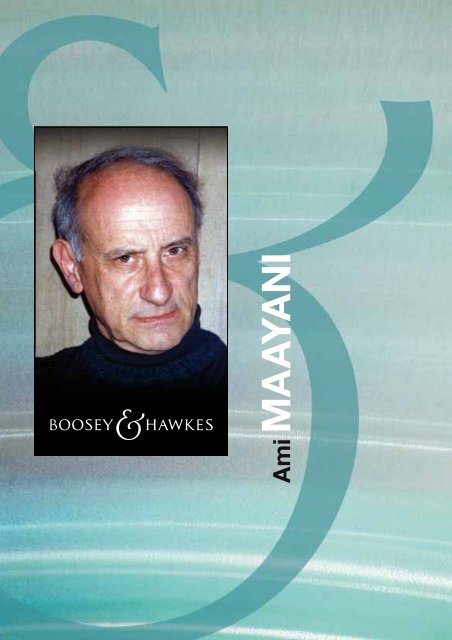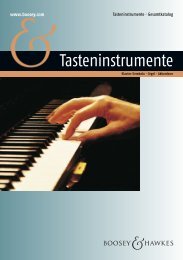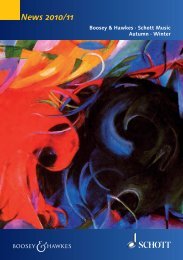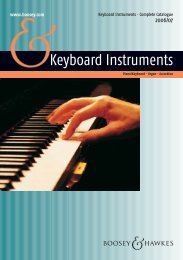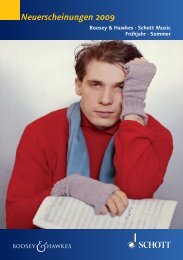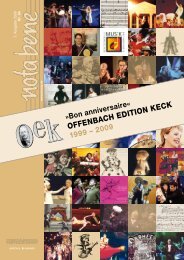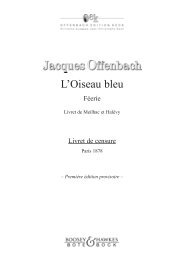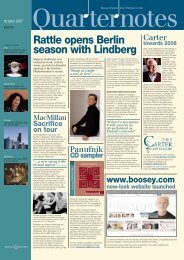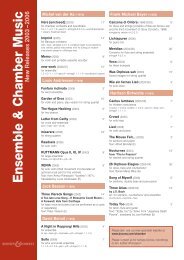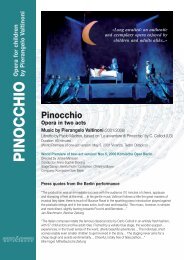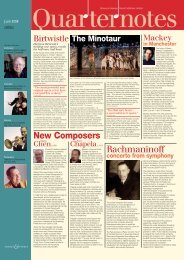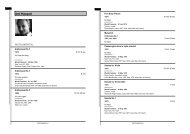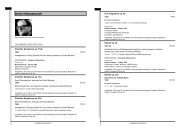Create successful ePaper yourself
Turn your PDF publications into a flip-book with our unique Google optimized e-Paper software.
<strong>MA</strong>AY<strong>ANI</strong><br />
Ami
TABLE OF CONTENTS<br />
Introduction 1<br />
Abbreviations 6<br />
Works 8<br />
Opera 8<br />
Ballet 9<br />
Full Orchestra 10<br />
Chamber Orchestra 12<br />
Solo Instrument(s) and Orchestra 13<br />
Vioce(s) and Orchestra 18<br />
Ensemble and Chamber without Voice(s) 21<br />
Instrumental 25<br />
Voice(s) 27<br />
Music for Tape 28<br />
Music for Harp 29<br />
Recordings 30<br />
Boosey & Hawkes addresses 34<br />
Composers list 36<br />
The Qumran caves near the Dead Sea – the Scrolls found here are the<br />
text source for Ami Maayani’s opera-oratorio The War of the Sons of Light<br />
Against the Sons of Darkness. Photo: Palphat LTD
INTRODUCTION<br />
Born 13 January 1936 at Ramat Gan near Tel-Aviv, composer Ami<br />
Maayani belongs to the second generation of the founders and<br />
builders of Tel-Aviv City. He graduated from the Academy of Music<br />
in Jerusalem as a violinist and violist in 1953 and pursued studies<br />
in composition under the tutorship of Paul Ben-Haim, and in conducting<br />
with Eitan Lustig (1956–1960). After three years of military<br />
service in the Israeli Defence Force, he continued his academic<br />
studies at the Technion, the Israeli Institute of Technology in architecture,<br />
and graduated with a B.Arch. in 1960. During the years<br />
1961–1962 and 1964–1965, he furthered his studies in New York<br />
City, in urban planning at the Columbia University, and at the Electro-Acoustic<br />
Music Center with Prof. Vladimir Ussachevsky.<br />
While practicing architecture, being involved in site planning of<br />
some major projects in Israel and designing public buildings<br />
and dwellings, he studied philosophy at the Tel-Aviv University,<br />
graduating with a M.A. in 1974. The subject of his thesis was the<br />
Philosophy of Music – Studies in the Aesthetic Writings of Hegel,<br />
Schopenhauer, Wagner and Nietzsche.<br />
Maayani is the founder and conductor of the Israel National Youth<br />
Orchestra, the Tel-Aviv Youth Orchestra, the Haifa Youth Orchestra<br />
and the Technion Symphony Orchestra. During the years 1970–<br />
1973 and 1976–1980, he was the chairman of the Israel Composers’<br />
league, chairing the Israeli Section of the ISCM.<br />
The years 1975–1980 saw Maayani as assistant director of the<br />
Rubin Academy of Music and Dance in Jerusalem, serving also<br />
as a member of the High Council of Culture and Arts. In 1984, he<br />
joined the faculty of the Samuel Rubin Israel Academy of Music<br />
at the Tel-Aviv University, today the Buchmann–Mehta School of<br />
Music, as a professor of composition and conducting. He headed<br />
the Academy between the years 1993–1998 and 2000–2004, the<br />
year of his retirement. Maayani designed and supervised the building<br />
of the Clairmont Concert Hall at the Academy, both architecturally<br />
and acoustically.<br />
During the years in which Maayani had been heading the Tel-Aviv<br />
Academy of Music, he developed the Symphony Orchestra and the<br />
vocal department. Among the major projects and performances<br />
with the orchestra which he conducted were many symphonies<br />
from the core repertoire (Haydn, Mozart, Beethoven, Bruckner,<br />
Mahler, Bartók, Hindemith and Saint-Saëns’ Third Symphony – the<br />
first performance in Israel with a pipe organ), and full productions<br />
supervised and conducted by him of the opera Saul and David by<br />
������������ 1
INTRODUCTION<br />
Carl Nielsen (Israeli premiere and the first performance ever outside<br />
Scandinavia) and Bizet’s Carmen.<br />
Maayani was a guest lecturer in leading American universities and<br />
music schools, and at the Central Conservatory of Music in Beijing,<br />
China, in 2004–2005.<br />
Although music always came first for Maayani, he was a practicing<br />
architect for over ten years. Simultaneously he started composing<br />
in 1959 and has ever since worked on his ever growing catalogue<br />
of compositions uninterruptedly. He has written for practically every<br />
genre, every instrument and instrumental combination. Although<br />
his catalogue demonstrates a partiality towards the harp – and his<br />
first major composition is a concerto for harp and orchestra (1960,<br />
premiered in 1963 in Holland) which was chosen as the obligatory<br />
work of the Israel International Harp Contest in 1965 and again at<br />
the International Harp Contest in Hartford, Connecticut, in 1969<br />
– his works include an opera, four symphonies, ballet music, two<br />
song cycles for voice and orchestra, eleven concerti for a solo<br />
instrument and orchestra, works for symphony orchestra, chamber<br />
music of all kinds, solo compositions for various instruments and<br />
electro-acoustic music.<br />
Numerous are the prizes and awards his œuvre has brought him;<br />
among them the ‘Engel’ prize of the Tel-Aviv municipality in 1963;<br />
the prize of the education and culture ministry in 1964; the ‘Casino<br />
de Divonne’ prize, Paris 1967; the IBA (Israeli Broadcasting Authority)<br />
prize for the celebrations of the 25th anniversary of the state<br />
of Israel, for his song cycle Jüdische Lieder in 1973; the ACUM<br />
(Society of Authors, Composers and Music publishers in Israel)<br />
prize in 1974; and an ACUM lifetime achievement award in 1994;<br />
1st prize for his Hebrew Requiem – Symphony No.3 in the International<br />
Holocaust Competition, held by the Hecht Foundation, Haifa<br />
1978, Landau prize for the arts of the ‘Payis’ (the state lottery in<br />
Israel) for his life works in 2001.<br />
Maayani’s music has been performed extensively in Israel, Eastern<br />
and Western Europe, USA, North and South America, China, Japan<br />
and Korea. He was the first Israeli composer whose music was<br />
heard in Russia, China, South Korea, and Peru. His composi tion<br />
Qumran – Symphonic Metaphor was the first Israeli composition<br />
work to be performed in Germany post World War II (Berlin 1974).<br />
Maayani’s represented Israel in the European and South American<br />
tours of the Israel Philharmonic Orchestra under Zubin Mehta. The<br />
Jerusalem Symphony Orchestra commissioned from him the Scherzo<br />
������������ 2
INTRODUCTION<br />
méditerranéen for its 1983 European tour as the representative<br />
Israeli work. This work was also chosen by Zubin Mehta for the<br />
South American tour of the Israeli Philharmonic Orchestra in 2006.<br />
Major performances of Maayani’s music took place in different<br />
cities: Mizmorim – Songs of Thanksgiving and Praise in New York<br />
with the American Symphony under Julius Rudel (1965); the first<br />
harp concerto in Utrecht, Holland, with Susanna Mildonian as<br />
soloist and the Utrecht Symphony Orchestra under Paul Huperts<br />
(1963); the Concerto for Percussion and Eight Wind Instruments in<br />
Paris, performed by the Ars Nova Ensemble conducted by Edgar<br />
Cosma (1967); Deux Madrigaux in Paris, with Chantal Mathieu and<br />
the Paris Woodwind Quintet (1974); Concerto symphonique for<br />
harp and orchestra in Heidelberg, with Florence Sitruk as soloist<br />
and the Heidelberg Philharmonic Orchestra under Romely Pfund<br />
(2002); Concerto for Piano and Orchestra in Beijing, China, with<br />
Albert Mamriev as soloist and the Beijing Symphony Orchestra<br />
under the baton of Tan Li Hua.<br />
������������ 3<br />
Ami Maayani<br />
with Zubin<br />
Mehta during<br />
a rehearsal of<br />
Régalim.<br />
Photo:<br />
Alan D. Cisco
INTRODUCTION<br />
Maayani won international recognition for his entire music written<br />
for the harp, which includes three concerti, chamber music for<br />
various ensembles and harp, thirty six songs for voice and harp,<br />
and solo harp compositions. Most of his harp music was commissioned<br />
by famous harpists such as Nicanor Zabaleta, Kathleen Alister,<br />
Lucile Lawrence, Edna Philips, Susanna Mildonian and Naoko<br />
Yoshino. His music was chosen as set pieces of various International<br />
Competitions in Israel, France, Switzerland, Russia, USA and<br />
Japan.<br />
Maayani sees himself as the successor of his master teacher Paul<br />
Ben-Haim (1897–1984), the founder of the Israel Mediterranean<br />
School and the style of music, and considers his own contribu tion<br />
to the contemporary Israeli and Jewish music thus: Maayani clearly<br />
defines his music as Eastern Mediterranean. He based his music<br />
on biblical cantillations and Jewish traditions, emphasizes version<br />
of the Ashkenazi and Sephardic liturgy, setting them into the perspective<br />
of the Baroque and Classical music forms blended with<br />
Impressionistic harmonies and colours of the Mediterranean trends<br />
(French Impressionistic composers); see the Twelve Fantasies<br />
for Piano in Prelude and Fugue Form, based on Medieval modes<br />
and Ethnic scales – homage to J. S. Bach commemorating the<br />
250th anniversary of his death in 2000. Maayani’s vocal music is<br />
Maayani conducts the Students Orchestra of the Samuel Rubin Israel Academy<br />
of Music at the Clairmont Hall, Tel-Aviv, designed by himself.<br />
Photo: Tel-Aviv University Press<br />
������������ 4
INTRODUCTION<br />
closely associated with the Old Hebrew language, since the time<br />
of the Old Testament through the Dead Sea Scrolls to the Jewish<br />
Poets of the ‘Golden Age’ of Spain and the Modern Hebrew, revived<br />
in Israel more than a hundred years ago. His music includes<br />
the Yiddish, Ladino and Aramaic languages used by Jews in the<br />
Diaspora.<br />
Most of Maayani’s music has been recorded and released in sixteen<br />
CDs by FONS Music Foundation.<br />
Maayani is also the author of a monumental and exhaustive mongraph<br />
on Richard Wagner (in three volumes) and on The Music of<br />
the Ancient Nations and The Music in Plato’s Dialogues, the only<br />
major contributions to these subjects to appear in the Hebrew language.<br />
FONS Music Foundation is preparing the publication of his<br />
autobiography.<br />
July 2009<br />
������������ 5
ABBREVIATIONS<br />
Deutsch English Français Italiano<br />
Holzbläser Woodwind Bois Legni<br />
picc Piccoloflöte piccolo petite flûte ottavino<br />
fl Flöte flute grande flûte flauto<br />
afl Altflöte alto flute flûte alto flauto contralto<br />
bfl Baßflöte bass flute flûte basse flauto basso<br />
rec Blockflöte recorder flûte à bec flauto dolce<br />
ob Oboe oboe hautbois oboe<br />
corA Englischhorn cor Anglais (English horn) cor anglais corno inglese<br />
cl Klarinette<br />
(in A oder B�)<br />
clarinet<br />
(in A or B�)<br />
clarinette<br />
(en la ou en si bémol)<br />
clarinetto<br />
(in la o in si bemolle)<br />
bcl<br />
E �cl Baßklarinette<br />
Es-Klarinette<br />
bass clarinet<br />
clarinet in E �<br />
clarinette basse<br />
petite clarinette<br />
clarinetto basso<br />
clarinetto in mi bemolle<br />
dbcl Kontrabaß klarinette double bass clarinet clarinette contrebasse clarinetto contrabbasso<br />
sax Saxophon saxophone saxophone sassofono<br />
bhn Bassetthorn basset horn cor de basset corno di bassetto<br />
bn Fagott bassoon basson fagotto<br />
dbn Kontrafagott double bassoon/<br />
contrabassoon<br />
contrebasson controfagotto<br />
Blechbläser Brass Cuivres Ottoni<br />
hn Horn horn cor corno<br />
crt Kornett cornet cornet cornetta<br />
flgn Flügelhorn flugelhorn bugle flicorno<br />
tpt Trompete trumpet trompette tromba<br />
trbn Posaune trombone trombone trombone<br />
btrbn Baßposaune bass trombone trombone basse trombone basso<br />
Schlagwerk Percussion Percussion<br />
Strumenti a<br />
percussione<br />
BD große Trommel bass drum grosse caisse grancassa<br />
bl Block block block block<br />
cast Kastagnetten castanets castagnettes castagnette<br />
chin.cym chinesisches Becken Chinese cymbal cymbales chinoises piatto cinese<br />
crot Crotales crotales crotales crotales<br />
cym Becken cymbal(s) cymbale(s) piatto/i<br />
dr Trommel/Drum drum tambour/drum tamburo/drum<br />
glsp Glockenspiel glockenspiel glockenspiel glockenspiel<br />
perc Schlagzeug/Percussion percussion percussion percussione<br />
SD kleine Trommel snare drum caisse claire tamburo militare<br />
susp.cym hängendes Becken suspended cymbal cymbale suspendue piatto sospeso<br />
(einzeln)<br />
(single)<br />
(seule)<br />
(singolo)<br />
t.bells Röhrenglocken tubular bells cloches tubulaires campane tubolari<br />
tamb Tamburin tambourine tambour de basque tamburello basco<br />
tam-t Tam-Tam tam-tam Tam-Tam tam-tam<br />
TD Wirbeltrommel tenor drum caisse roulante tamburo rullante<br />
tgl Triangel triangle triangle triangolo<br />
timp Pauken timpani timbales timpani<br />
tom-t Tom-Toms tom-toms Tom-Toms tom-tom<br />
tpl.bl Tempelblock(s) temple block(s) temple block(s) block cinese/i<br />
vib Vibraphon vibraphone vibraphone vibrafono<br />
wdbl Woodblock(s) woodblock(s) woodblock(s) woodblock<br />
xyl Xylophon xylophone xylophone xilofono<br />
Tasteninstrumente Keyboards Claviers<br />
Strumenti<br />
a tastiera<br />
pft Klavier piano piano pianoforte<br />
cel Celesta celesta célesta celesta<br />
hpd Cembalo harpsichord clavecin clavicembalo<br />
org Orgel organ orgue organo<br />
kbd Keyboard keyboard keyboard keyboard<br />
synth Synthesizer synthesizer synthesizer sintetizzatore<br />
������������� 6
ABBREVIATIONS<br />
Streicher Strings Cordes Archi<br />
vln Violine violin violon violino<br />
vla Viola viola alto viola<br />
vlc Violoncello cello violoncelle violoncello<br />
db Kontrabaß double bass/contrabass contrebasse contrabbasso<br />
Stimmen Voices Voix Voci<br />
colS Koloratursopran coloratura soprano soprano léger soprano leggero<br />
S Sopran soprano soprano soprano<br />
M Mezzosopran mezzo-soprano mezzo-soprano mezzosoprano<br />
A Alt alto alto contralto<br />
CT Countertenor countertenor contraténor contratenore<br />
T Tenor tenor ténor tenore<br />
dramBar dramatischer Bariton dramatic baritone bariton dramatique baritono drammatico<br />
highBar hoher Bariton high baritone bariton aigu baritono alto<br />
lyrBar lyrischer Bariton lyric baritone bariton lyrique baritono lirico<br />
Bar Bariton baritone bariton baritono<br />
BBar Baßbariton bass baritone bariton-basse basso-baritono<br />
B Baß bass basse basso<br />
Sprachen Languages Langues Lingue<br />
E englisch English anglais inglese<br />
F französisch French français francese<br />
G deutsch German allemand tedesco<br />
I italienisch Italian italien italiano<br />
Sonstiges Others Divers Diversi<br />
ampl verstärkt amplified amplifié amplificato<br />
ca circa circa circa circa<br />
elec. elektrisch/elektronisch electric/electronic électrique/électronique elettrico/elettronico<br />
gtr Gitarre guitar guitare chitarra<br />
hi hoch high aigu alto<br />
lg groß large grand grande<br />
lo tief low grave basso<br />
max. Maximum maximum maximum massimo<br />
med mittel medium moyen medio<br />
min Minuten minutes minutes minuti<br />
min. Minimum minimum minimum minimo<br />
sm klein small petit piccolo<br />
All other scorings are listed in full, or are a combination of the above.<br />
Standard order of instrumentation:<br />
fl.ob.cl.bn—hn.tpt.trbn.tuba—perc—other—vlnI.vlnII.vla.vlc.db<br />
Material on sale is indicated after each work entry. Where no parts are listed on sale,<br />
the work is available for rental.<br />
For more detailed information, please also visit www.boosey.com/Maayani and<br />
www.amimaayani.co.il<br />
������������� 7
�����<br />
The War of the Sons of Light Against<br />
the Sons of Darkness<br />
1971 1 hr 30 min<br />
Opera-oratorio based on the Dead Sea Scrolls<br />
Libretto by Alan Roland, with fragments from the Scroll<br />
and Roman Soldiers Song (E-Hebr-Lat)<br />
T,Bar,BBar,boy; mixed chorus; male chorus; dancers<br />
2.picc.2.corA.2.E�cl.bcl.2.dbn—6.4.3.1—timp.perc(4)—harp—cel—strings<br />
Roles:<br />
Teacher of Righteousness (Baritone)<br />
Alexander Jannaeus (Tenor)<br />
Titus (Bass-Baritone)<br />
The Messiah (boy of sixteen years)<br />
The Members of Qumran community, the Qumran warriors of Light,<br />
Roman legion soldiers<br />
Time and Place:<br />
At the crossroads of time between B.C.E. and C.E., in the community of the<br />
Dead Sea Scroll Sect at Qumran, overlooking the Dead Sea.<br />
Synopsis:<br />
During the hours just before dawn, apprehension is expressed by a chorus<br />
of the members of the Dead Sea Scroll Sect, concerning the approaching<br />
conquest by Roman power. They are reassured by their chief, the Teacher of<br />
Righteousness, who recalls how the people of Israel previously survived in exile<br />
and strove towards the Light under the state domination of both Egypt and<br />
Babylonia. During their recounting of past sufferings, Alexander Jannaeus, the<br />
tyrannical King who had persecuted the Sect, suddenly appears, called forth<br />
for Judgment from eternity's resting place. Also called upon in a prophetic<br />
vision of the Teacher is Titus, the as yet unborn Roman general, who later<br />
conquered Jerusalem, in order to view the future conquerors of Rome, to<br />
witness its final defeat. A confrontation develops between Light and Darkness,<br />
between spiritual illumination and earthly ambition and conquest. The tension<br />
of the confrontation gives birth to the great vision of the War Scroll, a final war<br />
between the forces of Light and Darkness. The Teacher in the vision describes<br />
the great battle between the Sons of Light, the spiritual heiress of the ancient<br />
Jewish tradition, and the Roman Legions, represented by Choruses and<br />
dancers, terminating in the victory of Light.<br />
Dawn arrives at Qumran with the appearance of the Messiah, proclaiming a<br />
new era of a great synthesis from amongst the Jewish, Greek and Roman<br />
genius. But it will be an era where the Messiah needs the dispersion of the<br />
Jews in order to be the welding force, the softening touch of conscience in<br />
the West. The teacher with profound sadness then calls the Sons of Light to<br />
voluntary exile, to repair their walking sticks and sandals, to wander over dunes<br />
to bring heavenly Jerusalem to all. Ami Maayani<br />
OPERA 8
������<br />
The Legend of Threes and Fours<br />
1978 1 hr 43 min<br />
Ballet music in three acts (twelve scenes)<br />
based on the legend of the same title by Hayim Nahman Bialik and verses<br />
from the Book of Proverbs 31,18<br />
2.picc.2.corA.2.bcl.2.dbn—6.4.3.1—timp.perc(4)—2harps—cel—strings<br />
Scenario:<br />
Act I: King Solomon and the Kings of East and West at the palace party; in<br />
the palace garden – King’s dream vision in the stars. The King’s daughter<br />
dances alone in the garden. In his room with his servants the King seeks a<br />
solution for the nightmare vision of his beloved daughter marrying a poor lad<br />
from Sidon.<br />
Act II: Sidon – a city of great commercial activity and much confusion; Natanya<br />
– a brave lad in search of adventure leaves Sidon and finds himself on a boat in<br />
the midst of the sea; The vessel crashes on a cliff; The lad is saved by the eagle<br />
who puts him on the deserted island in the middle of nowhere; There he sees a<br />
large tower tightly closed under lock and key, where King Solomon concealed<br />
his daughter to avoid Heaven’s decree; The serpent leads him to the top of the<br />
tower where the lad and the King’s daughter find themselves falling in love and<br />
involved with each other.<br />
Act III: King Solomon and his entourage reach the island; Stunned, he sees the<br />
young couple holding hands; he accepts the situation and understands that it<br />
was God’s will to bring them together; after a short interlude, they all participate<br />
in the great celebration in the city of Jerusalem. Ami Maayani<br />
‘Leading Astray’<br />
see below: Concerto for Percussion and Eight Wind Instruments<br />
The War of the Sons of<br />
Light Against the Sons of<br />
Darkness: Fragment from<br />
the Dead Sea Scroll –<br />
original first page.<br />
Photo: archive<br />
BALLET 9
��������������<br />
Qumran<br />
Symphonic Metaphor<br />
1970 16 min 30 sec<br />
Orchestral excerpts from the opera-oratorio The War of the<br />
Sons of Light against the Sons of Darkness<br />
2.picc.2.corA.2.bcl.2.dbn—6.4.3.1—timp.perc(4)—2harps—cel—strings<br />
Commissioned by Zubin Mehta and the Israel Philharmonic Orchesetra for its<br />
European tour 1974<br />
The ‘Symphonic Metaphor’ Qumran is based on the findings of the lost Scrolls<br />
of Essene sect in the Qumran Caves, on the Northwestern shores of the Dead<br />
Sea. The Essenes were an apocalyptic sect that existed in the early days of<br />
Christianity. A highly austere sect, they believed in the essence of Judaism, but<br />
the core of their faith was belief in the Day of Judgment, when the Sons of Light<br />
shall vanquish the Sons of Darkness.<br />
In the Judean Desert a pilgrim is facing the Qumran Caves. He hears the<br />
prayers and chants of the Essenes. The middle section portrays the apocalyptic<br />
battle in sound rising and falling as described in the Scroll of the war. The vision<br />
of the final Judgment spreads when the battle is over. The slow opening<br />
theme emerges but fades out into the eternal stillness of the desert. Ami Maayani<br />
‘This three-part piece for complex orchestra displays a superbly imaginative use<br />
of sound. Its slow beginning consists of spaciously arranged chords that, though<br />
indifferent in terms of tonality, evoke a very pleasant atmosphere. Gradually, motivic<br />
figures evolve from this static groundwork. One of them, consisting of a rising fourth<br />
and a falling whole note, dominates the vivid middle section and the recapitulation.<br />
Characterised by time changes and asymmetrical rhythms, the style is lent an oriental<br />
quality by wind melismas but otherwise maintains its personal signature. The musical<br />
language, which shows a certain inclination towards the tonic but is rather modal<br />
than tonal, is distinctively modern, without belonging to any of the established avantgarde<br />
schools. The composer expressed his gratitude for the work’s great success.’<br />
(Hans Heinz Stuckenschmidt, Frankfurter Allgemeine Zeitung, 14 Sep 1971)<br />
����������������������������<br />
Israel Festival, Jerusalem , Israel<br />
Israel Philharmonic Orchestra<br />
Conductor: Zubin Mehta<br />
Symphony No.2<br />
1975 50 min<br />
for orchestra<br />
2.picc.2.corA.2.bcl.2.dbn—6.4.3.1—timp.perc(4)—2harps—strings<br />
FULL ORCHESTRA 10
��������������<br />
Ouverture solenelle<br />
‘Jubilee 82’<br />
1982 10 min 30 sec<br />
2.picc.2.corA.2.bcl.2.dbn-6.4.3.1—timp.perc(4)—2harps—cel—strings<br />
Commissioned by the Israeli Philharmonic Orchestra for the 25th anniversary of<br />
the Philharmonic Auditorium (Mann), Tel-Aviv<br />
�������������������������������<br />
Tel-Aviv , Israel<br />
Israel Philharmonic Orchestra<br />
Conductor: Zubin Mehta<br />
Sinfonietta on Popular Hebrew Themes<br />
Symphony No.4<br />
1982 27 min 30 sec<br />
Originial version: 2.2.2.2—2.2.0.0—timp.perc(1)—strings<br />
Philharmonic verson: 2.2.2.2—4.2.0.0—timp.perc(2)—harp—strings<br />
Not many works have been written in which an attempt is made to combine<br />
Eastern and Western cultures, and featuring Jewish musical tradition – the<br />
traditional music as it was sung and played by the different communities, and<br />
as crystallized in the Western musical traditions of Central Europe. Israeli music<br />
has tried to present a kind of cultural encounter in the fifties and sixties of the<br />
20th century combining original Jewish musical elements with musical forms<br />
borrowed from the classical tradition. The Sinfonietta is written in the traditional<br />
classical style of the Symphony, with four movements, each based on folkloric<br />
material from different Jewish communities: I. Adagio, Allegro – based on three<br />
Yemenite Melodies; II. Variations on Sephardic Themes; III. Scherzo – based on<br />
‘Klezmerim Waltz’; IV. Finale – based on traditional melody of Persian Jewry.<br />
Ami Maayani<br />
��������������������������������������������������<br />
Tel-Aviv , Israel<br />
Israel Sinfonietta<br />
Conductor: Mendi Rodan<br />
Scherzo méditerranéen<br />
1983 11 min<br />
2.picc.2.corA.2.bcl.2.dbn—6.4.3.1—timp.perc(4)—harp—cel—strings<br />
Commissioned by the Jerusalem Symphony Orchestra for its European<br />
tour 1983<br />
�������������������������������<br />
Jerusalem , Israel<br />
Jerusalem Symphony Orchestra<br />
Conductor: Ole Schmidt<br />
FULL ORCHESTRA 11
�����������������<br />
Divertimento Concertante<br />
1959 15 min 30 sec<br />
1.1.2.1 —2.1.0.0—perc(1)—strings<br />
����������������������������<br />
Jerusalem , Israel<br />
Jerusalem Symphony Orchestra<br />
Conductor: George Singer<br />
Songs of King Solomon<br />
1962 13 min 30 sec<br />
strings(4.3.2.2.1)<br />
����������������������������<br />
Jerusalem , Israel<br />
Jerusalem Symphony Orchestra<br />
Conductor: Mendi Rodan<br />
Sinfonietta No.1<br />
1980 13 min 30 sec<br />
( Alternate version of Songs of King Solomon)<br />
1 .2.2.1—2.1.0.0—timp.perc(2)—harp—strings<br />
CHAMBER ORCHESTRA 12
��������������������������������<br />
Concerto for Harp and Orchestra No.1<br />
1960 28 min 15 sec<br />
1.picc.afl.2.corA.2.bcl.2.dbn—3.3.0.0—timp.perc(4)—cel—strings<br />
‘Engel’ Prize of the Tel-Aviv Municipality, 1963<br />
Obligatory Composition in the 3rd International Harp Contest, Israel 1965<br />
Obligatory Composition in the International Competition at Harford, CT,<br />
USA 1969<br />
Obligatory Composition in the 15th International Harp Contest, Israel 2003<br />
Reviews of participants, of the International Harp Week, Laren 1963:<br />
‘I think the Concerto is one of the best modern works written for the harp. The harp<br />
part is difficult but quite possible and will bring the students and harp players to a high<br />
level. I hope it will be played often and become one of the works performed in harp<br />
repertoire.’ (Maria Korchinska, England)<br />
‘It must be a great joy for any harpist to play Ami Maayani’s concerto. The composer<br />
knows the instrument exceptionally well and has given the harp a leading role, rather<br />
than a supplemental one.’ (Phia Berghout, Holland)<br />
‘I think this concerto is remarkable and an important work for the contemporary<br />
repertoire of the harp. The harp part is handled deftly and the color of the orchestra is<br />
wonderful. It was a huge pleasure to hear the premiere; I congratulate the composer<br />
and the performer, Susanna Mildonian, with all my heart.’ (Marcel Grandjany, USA)<br />
������������������������������<br />
International Harp Week, Laren , Netherlands<br />
Susanna Mildonian, harp<br />
Utrechts Stedelijk Orkest<br />
Conductor: Paul Huppers<br />
Concerto symphonique<br />
Concerto for Harp and Orchestra No.2<br />
1966 29 min 15 sec<br />
2.picc.2.corA.2.bcl.2.dbn—4.3.3.1—timp.perc(3)—harp—strings<br />
‘This music is like a rushing, mighty river at times, and at others like a broadly flowing<br />
mellow stream, which is nurtured by many springs but is characterized by an un -<br />
ambiguous intellectual landscape. The demanding solo part acts as an Ariadne thread<br />
through the whole structure.’ (Matthias Roth, Rhein-Neckar-Zeitung, 08 Feb 2002)<br />
‘The World Premiere of the dramatic three movements of the Concerto Symphonique<br />
pour Harpe which will, undoubtedly, enrich the sparse concert literature for harp, was a<br />
triumphant success... a work like a painting by Gauguin... calling forth an overwhelming<br />
association of topical flora and fauna.’ (Waltraud Brunst, Mannheimer Morgen,<br />
09 Feb 2002)<br />
������������������������������<br />
Heidelberg , Germany<br />
Florence Sitruk, harp<br />
Philharmonisches Orchester Heidelberg<br />
Conductor: Romely Pfund<br />
SOLO INSTRUMENT(S) AND ORCHESTRA 13
��������������������������������<br />
Concerto for Percussion and Eight Wind Instruments<br />
see below: Ensemble and Chamber Without Voice(s)<br />
Concerto for Violin and Orchestra<br />
1967 26 min 10 sec<br />
2.picc.2.corA.2.E�cl.bcl.2.dbn—2.2.1.1—timp.perc(3)—2harps—cel—strings<br />
Commissioned by the Israel Philharmonic Orchestra<br />
�������������������������������<br />
Tel-Aviv , Israel<br />
Yuval Waldman, violin<br />
Israel Philharmonic Orchestra<br />
Conductor: Uri Segal<br />
Concerto for Violoncello and Orchestra<br />
1967 28 min 15 sec<br />
2.picc.afl.2.corA.2.E�cl.bcl.2.dbn—2.2.1.1—timp.perc(3)—2harps—cel—<br />
strings<br />
‘... interesting and colorful music, distinctive in character and particular to its composer,<br />
while the genre is Western, melodic treatment and rhythmic patterns of the music<br />
of the Near East. Primarily a melodic piece, the highly inflected line occasionally<br />
resembles Cantillation, at other times is melismatic as in the second movement. The<br />
last movement is rhythmic. A clear and open texture allows the soloist to express the<br />
embellished line freely. Like a true concerto there is a good balance of activity between<br />
solo passages and orchestral passages.’ (Peter Farrell, ‘Notes’ – Journal of the Music<br />
Library Association, Dec 1982)<br />
���������������������������<br />
Jerusalem , Israel<br />
Uzi Wiesel, cello<br />
Jerusalem Symphony Orchestra<br />
Conductor: Mendi Rodan<br />
Concerto for Two Pianos and Orchestra<br />
1969 30 min<br />
2.picc.2.corA.2.bcl.2.dbn—4.3.3.1—timp.perc(3)—2harps—cel—strings<br />
�����������������������������<br />
Tel-Aviv , Israel<br />
Tami Kanazawa & Yuval Admoni, pianos<br />
Israel Symphony Orchestra Rishon LeZion<br />
Conductor: Xu Yi An<br />
SOLO INSTRUMENT(S) AND ORCHESTRA 14
��������������������������������<br />
Sinfonia Concertante<br />
for Woodwind Quintet and Orchestra<br />
1972 32 min<br />
0.0.0.0—0.4.4.1—timp.perc(4)—2harps—mand—pft(=cel)—2 string orchestras<br />
(1 tuned a quarter tone higher)<br />
Concerto for Viola and Orchestra<br />
1974 27 min 50 sec<br />
2.picc.2.corA.2.bcl.2.dbn—4.4.3.1—timp.perc(3)—2harps—cel—strings<br />
�������������������������������<br />
Jerusalem , Israel<br />
Daniel Binyamini, viola<br />
Jerusalem Symphony Orchestra<br />
Conductor: David Shallon<br />
Concerto for Guitar and Orchestra<br />
1976 27 min 10 sec<br />
1.picc.1.corA.2.bcl.2.dbn—2.2.1.1—timp.perc(4)—2harps—cel—strings<br />
Commissioned by Sharon Isbin<br />
‘This aesthetically magnificent and majestic masterpiece was presented in three<br />
movements. The first movement marked Modéré began with atonal, ethereal, filmy,<br />
gauzelike shades and tints plus interludes of meditative solo guitar. A relaxed tension<br />
inspired new sounds, dimensions, dissonance and resolutions. Dialogue with the<br />
celesta created a sense of profound drama. The second movement, Andante, was<br />
affirmatively masculine, resolutely tender. Silky strings and an emphatic harp created<br />
Oriental atmosphere reminiscent of a Japanese print... Vite et trés gai marked the last<br />
movement. Novel, unique and highly complex rhythms led to firm resolution, romantic<br />
hope and warmth. Interweaving melodies and themes became vertical, horizontal and<br />
diagonal gems of variation and beat. The final draped tones and lush dissonances<br />
drifted into space toward Nirvana and the celestial... concluding a work of great artistic<br />
merit.’ (Earl A. Schreiber, Winona Daily News, 12 Apr 1978)<br />
����������������������������<br />
Minneapolis, MN , USA<br />
Sharon Isbin, guitar<br />
Minnesota Orchestra<br />
Conductor: Henry Charles Smith<br />
SOLO INSTRUMENT(S) AND ORCHESTRA 15
��������������������������������<br />
Concertino for Harp and String Orchestra<br />
1980 23 min<br />
( or string nonet: 2.2.2.2.1)<br />
Commissioned by Nicanor Zabaleta<br />
‘... I like this brilliant, effective and beautiful work, and I consider it an important addition to<br />
the harp repertoire; the Concertino fulfilled my earlier expectations on commissioning it.’<br />
(Nicanor Zabaleta – Vila Izar, Spain, July 1981)<br />
������������������������������<br />
Tel-Aviv , Israel<br />
Ruth Maayani, harp<br />
Israel Chamber Orchestra<br />
Conductor: Ole Schmidt<br />
At the world premiere of the Concerto for Piano and Orchestra.<br />
Photo: Li Jin<br />
SOLO INSTRUMENT(S) AND ORCHESTRA 16
��������������������������������<br />
Arabesque No.4<br />
1983 12 min<br />
for flute, harp and string orchestra<br />
���������������������������<br />
Rochester, NY , USA<br />
Grace Wong, harp<br />
Rochester Symphony Chamber Ensemble<br />
Concerto for Piano and Orchestra<br />
Souvenirs de Chine<br />
2002 44 min 50 sec<br />
2.picc.2.corA.2.bcl.2.dbn—4.4.3.1—timp.perc(4)—harp—cel—strings<br />
‘The two main themes of the concerto are a Chinese folk tune and a Jewish melody.<br />
The entire structural layout of Maayani’s piano concerto was profoundly influenced<br />
by the adoption of the Chinese tune, and its mixture with elements of Jewish music<br />
results in a highly colorful and richly textured development. It seems as if a live<br />
dialogue between those two ancient nations, the Chinese and the Jewish, is taking<br />
place... Although Maayani follows traditional guidelines in this composition, the way he<br />
weeds out the old form in order to integrate the new into his work is a model that our<br />
Chinese composers can make use of. Maayani’s superb skills in traditional methods<br />
of composition creatively join together the significant part of characteristic Jewish<br />
music (ornaments, compound beat, compound harmony, etc.) in the masterwork with<br />
Chinese pentatonic scales. He succeeds in creating magnificent Oriental scenery in a<br />
Mediterranean style.’ (Zi Mo, ‘Music Weekly’ Journal, 09 Jun 2006)<br />
�������������������������������<br />
Forbidden City Concert Hall, Beijing , People's Republic of China<br />
Albert Mamriev, piano<br />
Beijing Symphony Orchestra<br />
Conductor: Tan Lihua<br />
L’Esprit baroque méditerranéen<br />
2007 30 min<br />
Three pieces for four harps and string orchestra<br />
Commissioned by the World Harp Congress 2008<br />
�����������������������������<br />
Amsterdam, Netherlands<br />
Quatuor de Harpes de Paris: Marie Saint-Bonnet / Sabin Chefson /<br />
Caroline Rempp / Agnes Kammerer<br />
Rotterdam Chamber Orchestra<br />
Conductor: Conrad Van Alphen<br />
SOLO INSTRUMENT(S) AND ORCHESTRA 17
����������������������<br />
Mizmorim<br />
Songs of Thanksgiving and Praise<br />
1965 15 min 10 sec<br />
for soprano (or tenor) and chamber orchestra<br />
Text: Psalms 131, 121 (Hebr)<br />
1.1.1.bcl.0—0.0.0.0—perc(2)—harp—strings<br />
Also available for voice and piano<br />
Commissioned by the Composers’ Showcase, New York, USA<br />
‘... a glowing, shimmering piece with an orchestral style somewhat influenced by Ravel<br />
and a sinuous folk-derived vocal line. Some delicate percussive effects add much to its<br />
effect.’ (Alan Rich, New York Herald Tribune, 11 Mar 1965)<br />
‘... a dissonant but exotic-sounding work with plenty of advanced effects.’<br />
(Harold C. Schonberg, New York Times, 11 Mar 1965)<br />
�������������������������������<br />
Philharmonic Hall, New York, NY , USA<br />
Janice Harsanyi, soprano<br />
American Symphony Orchestra<br />
Conductor: Julius Rudel<br />
Régalim<br />
Les Fêtes de pélérinage (Pilgrimage Feasts)<br />
1966 28 min 25 sec<br />
for soprano (or tenor) and large orchestra<br />
Text: Psalm 122, Isaiah 55,12 (Hebr)<br />
2.2picc.afl.3.corA.2.E�cl.2bcl.asax.tsax.3.dbn—6.4.4.1—timp.perc(8)—<br />
2harps—cel—strings<br />
Psalm 122 ‘Pray for the Peace of Jerusalem’ also available for voice and piano<br />
‘The music of Régalim contains all of Maayani’s characteristic features – oriental<br />
melodic pattern built out of small intervals, heterophony, obstinate melodic and<br />
rhythmical repetitions, impressionistic coloring, etc. The composer gives us an almost<br />
visual description of the holy pilgrimage to the Temple: the festive Proclamation, the<br />
mysterious Prayer and the almost pagan, ecstatic Dance of Spring. In these three<br />
sections Maayani carries one away by sheer orchestral force – sweeping rhythm and<br />
melodic obstinacy... All this prepares the listener for the beautiful vocal part, a lyrical yet<br />
almost emotional interpretation of Psalm 122: the last movement, ‘Procession’, with its<br />
alternating vocal and instrumental parts is probably the most original part...’ (Benjamin<br />
Bar-Am, Jerusalem Post, 19 Oct 1969)<br />
�������������������������������<br />
Tel-Aviv , Israel<br />
Raquel Adonaylo, soprano<br />
Israel Philharmonic Orchestra<br />
Conductor: Zubin Mehta<br />
VOICE(S) AND ORCHESTRA 18
����������������������<br />
Jüdische Lieder – Cycle No.1<br />
Yiddish Songs<br />
1973 22 min 35 sec<br />
Six Songs for soprano (or baritone) and orchestra<br />
Text: Levick, Suzkover, Asia Guy & Pappernikov (Yid)<br />
2.picc.2.corA.2.bcl.2.dbn—4.4.3.1—timp.perc(4)—2harps—cel—strings<br />
The IBA Israel Broadcasting Authority Prize for the 25th Anniversary of Israel<br />
�������������������������������<br />
Jerusalem , Israel<br />
Willi Haparnass, baritone<br />
Jerusalem Symphony Orchestra<br />
Conductor: Mendi Rodan<br />
Jüdische Lieder – Cycle No.2<br />
Yiddish Songs<br />
1974 25 min 10 sec<br />
Five songs for mezzo-soprano and orchestra<br />
Text: Asia Guy (Yid)<br />
2.picc.2.corA.2.bcl.2.dbn—4.4.3.1—timp.perc(4)—2harps—cel—strings<br />
Also available for voice and piano<br />
�������������������������������<br />
Jerusalem , Israel<br />
Mira Zakai, alto<br />
Jerusalem Symphony Orchestra<br />
Conductor: Ami Maayani<br />
Symphonie de psaumes<br />
Symphony No.1<br />
1974 52 min<br />
for soprano, baritone, SATB choir, children's choir<br />
and orchestra<br />
Text: from Psalms 60, 53, 15, 150, 147, 67, 85 (Hebr)<br />
2.picc.2.corA.2.bcl.2.dbn—6.4.3.1—timp.perc(4)—2harps—cel—strings<br />
VOICE(S) AND ORCHESTRA 19
����������������������<br />
Hebrew Requiem<br />
Symphony No.3<br />
1977 51 min<br />
for mezzo-soprano, SATB choir and orchestra<br />
Text: Yitzhak Averbuch Opraz (Hebr)<br />
2.picc.2.corA.2.bcl.2.dbn—6.4.3.1—timp.perc(4)—2harps—cel—strings<br />
1st Prize in International Competition ‘Holocaust and Rebirth’, 1978<br />
The original idea was to create a Requiem in the traditional Western European<br />
form and style. The Hebrew poems are interwoven with the Latin text of the<br />
Requiem Mass. This structure was later changed to a symphonic form. The work<br />
is now a mixture of the Romantic symphonic tradition with the Mediterranean<br />
esprit. Ami Maayani<br />
‘Maayani’s Hebrew Requiem is a masterpiece – monumental, profound and deeply<br />
moving. It has a wonderful balance between the instrumental and vocal parts and<br />
Yitzhak Orpaz’s beautiful poetry shapes the work’s spiritual world... The first movement<br />
To the Memory of My Father and Mother erupts turbulently and then settles down to a<br />
dirge-like slow section which is declamatory in style. Edna Prochnik’s voice rose from<br />
depth to dramatic heights with complete stability. The second movement Farwell:<br />
Dead, Dead is the Prophet is no less absorbing. The choir now moves into focus, giving<br />
cries from all directions which remain unanswered. There are dialogues which are cut<br />
off. Distress and pain are everywhere. The third movement, the scherzo-Ode is wild. In<br />
classic A–B–A form its main A section Halleluya uses a basic motif of simple diatonic,<br />
three-tone sequence of two major seconds which assume overpowering strength.<br />
When the motif returns after the lyrical B section the effect is breathtaking. The fourth<br />
movement is a wild dithyrambic hymn in honour of Jerusalem. Maayani has always<br />
had a marvelous talent for Orchestration and his Hebrew requiem opens up ever new<br />
horizons in his music. The essence of the Middle East is clearly there but the work<br />
also encourages a more universal language.’ (Benyamin Bar-Am, Jerusalem Post,<br />
11 Apr 1990)<br />
������������������������������<br />
Tel-Aviv , Israel<br />
Edna Prochnik, mezzo-soprano<br />
Opera Choir<br />
Jerusalem Choir<br />
Chamber Choir of Rishon LeZion<br />
Israel Symphony Orchestra Rishon LeZion<br />
Conductor: Ami Maayani<br />
Adam and Eve<br />
Cantata Aramaica<br />
2009 35 min<br />
for mixed choir, soprano, tenor & baritone soloists and ensemble<br />
Text: (Aramaic)<br />
0.0.0.0—3.3.3.1—perc(4)—harp ��<br />
VOICE(S) AND ORCHESTRA 20
�������������������������������������<br />
Concerto pour octuor<br />
Concerto méditerranéen<br />
1963 22 min 40 sec<br />
fl.ob d'Amore.bcl—tpt—harp—hpd—vla.db<br />
�������������������������������<br />
Tel-Aviv , Israel<br />
‘Kaprizma’ Ensemble<br />
Conductor: Israel Sharon<br />
Poème<br />
1965 12 min 10 sec<br />
for flute, violin, viola and cello<br />
Commissioned by the Beth El Synagogue<br />
����������������������������<br />
Larchmont, NY , USA<br />
Concerto for Percussion and Eight Wind<br />
Instruments<br />
1966 25 min 35 sec<br />
1.1.1.1—1.2.1.0<br />
Version for percussion and two pianos (1993)<br />
Winner of Casino de Divonne, International Competition for Chamber Music,<br />
Paris 1967<br />
����������������������������<br />
Paris , France<br />
Jean Charles François, percussion<br />
Ensembe Ars Nova<br />
Conductor: Edgar Cosma<br />
Improvisation variée<br />
1966 17 min 10 sec<br />
for harp, flute and violin<br />
Revised version as Trio for harp, flute and viola (or violin), 1975<br />
Commissioned by the Kathleen Alister Harp Trio, Johannesburg, South Africa<br />
������������������������������<br />
Johannesburg , South Africa<br />
Kathleen Alister, harp / Lucien Grujon, flute / Walter Mony, violin<br />
ENSEMBLE AND CHAMBER WITHOUT VOICE(S) 21
�������������������������������������<br />
Three Preludes<br />
1968 20 min 25 sec<br />
for percussion quartet<br />
Also version for percussion ensemble and piano<br />
����������������������������<br />
Israel Festival, Tel-Aviv , Israel<br />
Israel Philharmonic Percussion Ensemble<br />
Conductor: Mendi Rodan<br />
Deux Madrigaux<br />
1969 16 min 20 sec<br />
for harp and wind quintet<br />
fl.ob.cl.bn—hn—harp<br />
Commissioned by the Edna Phillips Foundation, Philadelphia, USA<br />
����������������������������<br />
Paris , France<br />
Chantal Mathieu, harp<br />
Quintette à vent de Paris<br />
Concerto for Percussion and Eight Wind Instruments as choreographed by<br />
Moshe Efrati under the title ‘Leading Astray’ and performed by the Royal<br />
Ballet of Flanders, Belgium; Moshe Efrati’s choreography was also performed<br />
by the Efrati Dance Company, Israel.<br />
Photo: Yoram Rubin<br />
ENSEMBLE AND CHAMBER WITHOUT VOICE(S) 22
�������������������������������������<br />
Arabesque No.2<br />
1973 9 min 30 sec<br />
for flute and harp<br />
�������������������������������<br />
New York, NY , USA<br />
Gretchen Pusch, flute / Karen Kolin, harp<br />
Arabesque No.3<br />
1973 9 min<br />
for harp quartet<br />
Commissioned by the New York Harp Quartet<br />
����������������������������<br />
2 nd World Harp Congress, Jerusalem , Israel<br />
Israel Harp Ensemble<br />
Quartet<br />
1975 15 min 30 sec<br />
for harp and string trio<br />
������������������������������<br />
New York, NY , USA<br />
Sara Cutler, harp<br />
The Jewish and Art School Trio<br />
Brass Quintet<br />
1977 23 min 55 sec<br />
for two trumpets, horn, trombone and tuba<br />
Commissioned by the Tel-Aviv Foundation for Literature and Art<br />
�������������������������������<br />
Tel-Aviv , Israel<br />
Israel Philharmonic Brass Quintet<br />
Serenade in D Major<br />
������������������������������������<br />
arr.1980 26 min 10 sec<br />
arranged flute, viola and harp<br />
����������������������������<br />
Tel-Aviv , Israel<br />
Uri Shoam, flute / David Chen, viola / Ruth Maayani, harp<br />
ENSEMBLE AND CHAMBER WITHOUT VOICE(S) 23
�������������������������������������<br />
Sonatine en trio<br />
1985 24 min<br />
for clarinet (or violin), cello and piano<br />
Commissioned by the Tel-Aviv Foundation for Literature and Art<br />
����������������������������������(Version for clarinet, cello and piano)<br />
Tel-Aviv , Israel<br />
Camerata Trio<br />
String Quartet<br />
1998 30 min 15 sec<br />
���������������������������������<br />
Moscow , Russia<br />
‘ Musica Viva’ String Quartet<br />
String Trio<br />
1999 26 min 30 sec<br />
���������������������������������<br />
Moscow , Russia<br />
‘Musica Viva’ String Trio<br />
Partita en mode phrygien<br />
2007 30 min<br />
f or violin and harp<br />
����������������������������<br />
Henry Crown Hall, Jerusalem, Israel<br />
Sivann Maayani Zelikoff, violin / Ruth Maayani, harp<br />
ENSEMBLE AND CHAMBER WITHOUT VOICE(S) 24
������������<br />
Avant propos<br />
Deux Préludes pour piano<br />
1958 7 min 35 sec<br />
for piano<br />
Toccata<br />
1961, rev.1969 6 min 15 sec<br />
for harp<br />
Obligatory Composition for the 2 nd International Harp Contest, Israel 1962<br />
Israel Ministry of Tourism Prize, 1962<br />
Maquamat<br />
Arabesque No.1<br />
1961, rev.1984 6 min 50 sec<br />
for harp<br />
����������������������<br />
Susanna Mildonian<br />
Five Pieces for the Young Harpist<br />
1974 10 min 35 sec<br />
for harp (Pedagogical work)<br />
������������������������<br />
Tel-Aviv , Israel / Ruth Maayani<br />
Deux impromptus<br />
1974/76 16 min 35 sec<br />
for piano<br />
No.2: Obligatory Israeli Composition for the Arthur Rubinstein Piano Competition,<br />
Israel 1986<br />
����������������������������<br />
Tel-Aviv , Israel / Sara Fuxon Heyman<br />
Passacaglia dans le style oriental<br />
1975 9 min 10 sec<br />
for harp<br />
Obligatory Composition for the 9 th International Harp Contest, Israel 1985<br />
����������������������������<br />
New York, NY , USA / Grace Wong<br />
INSTRUMENTAL 25
������������<br />
Sonata for Solo Violin<br />
1978 23 min 30 sec<br />
Commissioned by the Tel-Aviv Foundation for Literature and Art<br />
������������������������������<br />
Music Center, Jerusalem , Israel<br />
Lydia Mordkovitch<br />
Sonata No.1<br />
1979 13 min 50 sec<br />
for harp<br />
����������������������������<br />
New York, NY , USA<br />
Grace Wong<br />
Sonata for Solo Cello<br />
1979 17 min<br />
Commissioned by the Tel-Aviv Foundation for Literature and Art<br />
������������������������������<br />
Tel-Aviv , Israel<br />
Alexander Kagonowsky<br />
Sonatina for Guitar<br />
1979 11 min 55 sec<br />
Commissioned by the Tel-Aviv Foundation for Literature and Art<br />
�����������������������������<br />
Tel-Aviv , Israel<br />
Naftali Lahav<br />
Sonata No.2<br />
1990 19 min 10 sec<br />
for harp<br />
����������������������������<br />
Tokyo , Japan<br />
Naoko Yoshino<br />
VOICE(S) 26
������������<br />
Arabesque No.5<br />
1999 13 min 45 sec<br />
for organ<br />
������������������������������<br />
Kansas City, MO , USA<br />
Sabin Levi<br />
Twelve Fantasies in Prelude and Fugue Form<br />
based on medieval modes and ethnic scales<br />
2000 1 hr 17 min<br />
for piano<br />
Homage to Bach (250 th Anniversary of his death) and Shostakovich<br />
(50 th Anniversary of the composition of his Preludes and Fugues)<br />
�������������������������������<br />
Tel-Aviv , Israel<br />
Senior piano professors of the Israeli Academy of Music, Tel-Aviv University<br />
VOICE(S)<br />
Hebrew Poems from Spain<br />
Book I: Twelve Poems in Hebrew<br />
1997 22 min 30 sec<br />
for voice and harp<br />
Text: Moses Ibn-Ezra, Judah Ha-Levi, Samuel Ha-Nagid, Solomon Ibn Gabirol<br />
�������������������������������<br />
Upper Galilee Music Days, Kibbutz Kfar Blum , Israel<br />
Anna Skibinsky, soprano / Anat Eini, alto / Guy Bonné, bass-baritone /<br />
Ruth Maayani, harp<br />
Hebrew Poems from Spain<br />
Book II: Ten Poems In English Translation<br />
1997 19 min 30 sec<br />
for voice and harp<br />
Text: Moses Ibn-Ezra and unknown Medieval poets; English translation by<br />
Israel Abrahams<br />
�����������������������������<br />
Upper Galilee Music Days, Kibbutz Kfar Blum , Israel<br />
Anna Skibinsky, soprano / Anat Eini, alto / Guy Bonné, bass-baritone /<br />
Ruth Maayani, har p<br />
VOICE(S) 27
��������<br />
Hebrew Poems from Spain<br />
Book III: Six Love Songs<br />
1999 10 min 30 sec<br />
for voice and harp<br />
Text: Moses Ibn-Ezra; English translation by Israel Abrahams<br />
�����������������������������<br />
Upper Galilee Music Days, Kibbutz Kfar Blum , Israel<br />
David Sebba, baritone / Ruth Maayani, har p<br />
Hebrew Poems from Spain<br />
Book IV: Eight Wine Songs<br />
1999 22 min 10 sec<br />
for voice and harp<br />
Text: Samuel Ha-Nagid, Moïse Ben Jacob Ben-Ezra; French translation by<br />
Célestin de Mouilleron<br />
�����������������������������<br />
Upper Galilee Music Days, Kibbutz Kfar Blum , Israel<br />
Silvie Bendova, soprano / Ira Barski, mezzo-soprano / David Sebba, baritone /<br />
Ruth Maayani, har p<br />
Five Sephardic Songs<br />
on Ladino lyrics<br />
2001 12 min 30 sec<br />
for mixed choir a cappella<br />
�����������������������������<br />
Vilnius, Lithuania<br />
Vilnius Municipal Choir ‘Jauna Muzika’<br />
Conductor: Vaclovas Augustinas<br />
MUSIC FOR TAPE<br />
Study No.1<br />
1965<br />
Study No.2<br />
1965<br />
Microtonos<br />
1965<br />
MUSIC FOR TAPE 28
��������������<br />
Solo<br />
Toccata ....................................................................................... see page 25<br />
Maquamat (Arabesque No.1) ................................................................... 25<br />
Passacaglia dans le style oriental .......................................................... 25<br />
Sonata No.1 ................................................................................................ 26<br />
Sonata No.2 ................................................................................................ 26<br />
Five Pieces for the Young Harpist ........................................................... 25<br />
Voice(s) and Harp<br />
36 Hebrew Poems from Spain – Book I–IV ........................................ 27/28<br />
Duet<br />
Arabesque No.2 for flute and harp ............................................................. 23<br />
Partita en mode phrygien for violin and harp ........................................... 24<br />
Trio<br />
Improvisation variée for harp, flute and violin ........................................... 21<br />
Serenade in D Major op.25 (Beethoven), arranged flute, viola and harp .... 23<br />
Quartet<br />
Arabesque No.3 for harp quartet ............................................................... 23<br />
Quartet for harp and string trio ................................................................... 23<br />
Sextet<br />
Deux Madrigaux for harp and wind quintet .............................................. 22<br />
Harp(s) and Orchestra<br />
Concerto for Harp and Orchestra No.1 .................................................. 13<br />
Concerto symphonique (Concerto for Harp and Orchestra No.2) ..... 13<br />
Concertino for Harp and String Orchestra ............................................ 16<br />
Arabesque No.4 for flute, harp and string orchestra .................................. 17<br />
L’Esprit baroque méditerranéen for four harps and string orchestra ..... 17<br />
MUSIC FOR HARP 29
RECORDINGS<br />
FONS Music Foundation<br />
(Available at sivzel@hotmail.com / Fax: +972–3–6040735)<br />
Music for Harp:<br />
Triptique (Toccata – Maquamat – Passacaglia) / Sonatas No.1 & 2 /<br />
Five Pieces for the Young Harpist<br />
Naoko Yoshino<br />
IMP Digital – FONS 02-9420<br />
Four Baroque Sonatas:<br />
Sonata for Solo Violin / Sonata for Solo Cello / Sonatina for Guitar /<br />
Sonatine en trio for violin, cello and piano<br />
Bing Jing Yu, violin / Natalia Khoma, cello / Tali Roth, guitar / Orit Wolf, piano<br />
IMP Digital – FONS 01-2096 (2 CD Album)<br />
Piano Music – Percussion Music:<br />
Avant Propos – Deux Préludes pour piano / Deux Impromptus / Concerto<br />
for Percussion and Two Pianos / Three Preludes<br />
Aviram Reichert, Orit Wolf, Josef Reshef, pianos / Chen Zimbalista, percussion /<br />
The Israel Academy of Music Percussion Ensemble / Alon Bor, conductor<br />
IMP Digital – FONS 02-2096 (2 CD Album)<br />
Harp Trios:<br />
Beethoven–Maayani / Ibert / Debussy<br />
Amir Sela, flute / Fiona Vanderspar-Simon, violin / Richard L. Simon, viola /<br />
Ruth Maayani, harp<br />
FONS 36-2001<br />
Maayani Conducts Maayani:<br />
Jüdische Lieder – Song Cycle No.2<br />
Edna Prochnik, mezzo-soprano / Odessa Philharmonic Orchestra<br />
Concerto for Percussion and Eight Wind Instruments<br />
Gideon Steiner, percussion / Israel Philharmonic Ensemble<br />
FONS 36-2002<br />
Harp Chamber Music:<br />
Arabesques No.1 & 2 / Trio for Harp, Flute and Viola / Quartet for Harp and<br />
String Trio / Deux Madrigaux<br />
Ruth Maayani, harp / Noam Buchman, flute / Nitai Zori, violin / Gad Lewertoff, viola /<br />
Hillel Zori, cello / The Israel Woodwind Quintet<br />
FONS 36-2003<br />
Music for Violin:<br />
Concerto for Violin and Orchestra / Sonata for Violin Solo<br />
Lydia Mordkovitch, violin / Jerusalem Symphony Orchestra / Mendi Rodan<br />
FONS 36-2004<br />
RECORDINGS 30
RECORDINGS<br />
The Harp Concerti:<br />
Concerto No.1 for Harp and Orchestra<br />
Susanna Mildonian, harp / Jerusalem Symphony Orchestra / Carl St. Clair<br />
Concertino for Harp and String Orchestra<br />
Ruth Maayani, harp / The T. A. String Nonet / Nayden Todorov<br />
Arabesque No.3 for Harp Quartet<br />
The Pacific Harp Ensemble<br />
FONS 36-2006<br />
Concerto for Viola and Orchestra<br />
Daniel Benyamini, viola / Jerusalem Symphony Orchestra / David Shallon<br />
Concerto for Guitar and Orchestra<br />
Sharon Isbin, guitar / The Jerusalem Symphony Orchestra / Kazuhiro Koizumi<br />
FONS 36-2007<br />
Symphonic Music:<br />
Régalim / Qumran / Ouverture solenelle / Scherzo méditerranéen<br />
Israel Philharmonic Orchestra / Jerusalem Symphony Orchestra / Zubin Mehta,<br />
Eliahu Inbal, Laurence Foster, conductors<br />
FONS 36-2008<br />
Hebrew Poems from Spain – Books I–IV<br />
Anna Skibinsky, Marla Joffe, Silvie Bendova, sopranos / Ira Barsky, mezzo-soprano /<br />
Anat Eini, alto / David Sebba, baritone / Guy Bonné, bass-baritone / Ruth Maayani, harp<br />
FONS 36-2009<br />
Chamber Music:<br />
Poème<br />
Noam Buchman, flute / Yigal Tuneh, violin / Miriam Hartman, viola / Alexander<br />
Kaganovski, cello<br />
Sonatine en trio<br />
Yevgeny Yehudin, clarinet / Hillel Zori, cello / Orit Wolf, piano<br />
Brass Quintet<br />
Ram Oren, Yigal Meltzer, trumpets / Michael Slatkin, french horn / Stewart Taylor,<br />
trombone / Shmuel Hershko, tuba<br />
FONS 36-2010<br />
Arabesques No.1–5<br />
1: Grace Wong, harp<br />
2: Noam Buchman, flute / Ruth Maayani, harp<br />
3: The Pacific Harp Ensemble<br />
4: Noam Buchman, flute / Ruth Maayani, harp / Chamber Ensemble of the Israel<br />
Academy of Music, Tel-Aviv University / Ami Maayani<br />
5: Sabin Levi, organ<br />
FONS 36-2011<br />
RECORDINGS 31
RECORDINGS<br />
Twelve Fantasies for Piano in Prelude and Fugue Form<br />
Artists of the Faculty of the Tel-Aviv Academy of Music, Tel-Aviv University / Children<br />
from the Givatayim Conservatory<br />
FONS 36-2012-2 (2 CD Album)<br />
String Quartet / String Trio<br />
Alexander Mayorov, Natalya Yuchimchuk, violins / Anton Yaroshenko, viola /<br />
Alexey Makarov, cello<br />
FONS 36-2013<br />
Concerto pour octour (Concerto méditerranéen)<br />
Marcelo Ehrlich, flute / Dima Malkin, oboe d’amore / Elad Avakrat, bass clarinet /<br />
Naama Golan, trumpet / Gitit Alpert Boazson, harp / Yizhar Kershon, harpsichord /<br />
Amos Boazson, viola / Eyal Ganor, double bass / Israel Sharon, conductor<br />
Concerto Symphonique<br />
Florence Sitruk, harp / Philharmonisches Orchester Heidelberg / Romely Pfund<br />
FONS 36-2014<br />
‘Between Yiddish and Ladino’:<br />
Jüdische Lieder – Song Cycles No.1 & 2<br />
Willy Haparnass, baritone / Mira Zakai, alto / Jerusalem Symphony Orchestra /<br />
Mendi Rodan, Ami Maayani, conductors<br />
Five Sephardic Songs<br />
Vilnius Municipal Choir ‘Jauna Muzika’ / Vaclovas Augustinas<br />
FONS 36-2016<br />
Violin and Harp Music:<br />
Partita en mode phrygien / Sonata for Solo Violin / Passacaglia dans le<br />
style oriental<br />
Sivann Maayani Zelikoff, violin / Ruth Maayani, harp<br />
FONS 36-2017<br />
Other Labels (choice)<br />
Sinfonietta on Popular Hebraic Themes (Symphony No.4)<br />
Israel Sinfonietta / Mendi Rodan<br />
Music in Israel MII-CD-9<br />
Poème<br />
Noam Buchman, flute / Yigal Tuneh, violin / Miriam Hartman, viola /<br />
Alexander Kaganovski, cello<br />
Music in Israel MII-CD-2D<br />
Sonata for Solo Harp<br />
Naoko Yoshino<br />
Sony 30DC 5311<br />
Sonatina for Guitar<br />
Tali Roth<br />
John Foxx Records 634479937477<br />
Toccata for Solo Harp<br />
Chantal Mathieu<br />
Eurodisc 259 515<br />
RECORDINGS 32
Maayani conducts Maayani: World premiere of Hebrew Requiem.<br />
Photo: Yaakov Aviram
ADDRESSES<br />
Website http://www.boosey.com/composers<br />
Germany Boosey & Hawkes / Bote & Bock GmbH<br />
Lützowufer 26, 10787 Berlin<br />
Tel: +49 (30) 2500 1300, Fax: +49 (30) 2500 1399<br />
composers.germany@boosey.com (Promotion)<br />
leihbibliothek@boosey.com (Hire)<br />
United Kingdom Boosey & Hawkes Music Publishers Limited<br />
Aldwych House, 71–91 Aldwych, London WC2B 4HN<br />
Tel: +44 (20) 7054 7200, Fax: +44 (20) 7054 7290<br />
composers.uk@boosey.com (Promotion)<br />
hirelibrary.uk@boosey.com (Hire)<br />
USA Boosey & Hawkes Inc.<br />
35 East 21st Street, New York, NY 10010<br />
Tel: +1 (212) 358 5300, Fax: +1 (212) 358 5306<br />
composers.us@boosey.com (Promotion)<br />
hirelibrary.us@boosey.com (Hire)<br />
Boosey & Hawkes is an Imagem company.<br />
In the following countries Boosey & Hawkes operates through agents<br />
with whom enquiries should be made and orders placed.<br />
For countries not listed please contact Boosey & Hawkes in London.<br />
Australia Hal Leonard Australia Pty. Ltd.<br />
4 Lentara Court, Cheltenham Victoria 3192<br />
Tel: +61 (3) 9585 3300, ausclassical@halleonard.com.au<br />
Austria Boosey & Hawkes / Bote & Bock GmbH (see Germany)<br />
Belgium Durand–Salabert–Eschig (see France)<br />
Auteursbureau ALMO PVBA (for stage works only)<br />
Jan van Rijswijcklaan 282, 2020 Antwerp<br />
Tel: +32 (3) 260 6810/14, info@almo.be<br />
Canada Boosey & Hawkes Inc. (see USA)<br />
Croatia Hrvatsko Društvo Skladatelja ZAMP<br />
Berislaviceva 7/11, 10000 Zagreb<br />
Tel: +385 (1) 4816 909, suzana.markovic@hds.hr<br />
Czech Republic Editio Bärenreiter Praha s.r.o.<br />
Bechovicka 26, 100 00 Praha 10<br />
Tel: +420 (2) 7400 1925, hire@ebp.cz<br />
Dilia (for stage works only)<br />
Krátkého 1, 190 03 Praha 9<br />
Tel: +420 266 199 836, info@dilia.cz<br />
Denmark Edition Wilhelm Hansen AS<br />
Bornholmsgade 1, 1266 Kobenhavn K<br />
Tel: +45 3311 7888, ewh@ewh.dk<br />
Estonia & Finland Fennica Gehrman<br />
PO Box 158, 00121 Helsinki, Finland<br />
Tel: 358 (9) 7590 6311, info@fennicagehrman.fi<br />
France Durand–Salabert–Eschig (Universal Music Publishing Group)<br />
16 rue des Fossées Saint-Jacques, 75005 Paris<br />
Tel: +33 (1) 4441 5071, location.rental@umusic.com<br />
Greece SOPE Hellas<br />
51 Samou Street, 151 25 Amaroussio<br />
Tel: +30 (210) 685 7481, sope@hol.gr<br />
��������� 34
ADDRESSES<br />
Hungary Editio Musica Budapest<br />
Victor Hugó utca 11–15, 1132 Budapest<br />
Tel: +36 (1) 236 1100, emb@emb.hu<br />
Iceland Gehrmans Musikförlag AB (see Sweden)<br />
Israel Samuel Lewis<br />
4/53 El-Al Street, Herzlia B 46588<br />
Tel: +97 (2) 9955 3017, samlewis@zahav.net.il<br />
Italy Universal Music Publishing Ricordi S.r.l.<br />
Via Liguria 4, fr. Sesto Ulteriano, 20098 S. Giuliano Milanese<br />
Tel: +39 (2) 98813 4318, rental.ricordi@umusic.com<br />
Japan Schott Japan Company<br />
Kasuga Building, 2-9-3 Iidabashi, Chiyoda-ku, Tokyo 102-0072<br />
Tel: +81 (3) 3263 6530, info@schottjapan.com<br />
Latvia & Lithuania Gehrmans Musikförlag AB (see Sweden)<br />
Mexico Boosey & Hawkes Inc. (see USA)<br />
Netherlands Albersen Verhuur v.o.f.<br />
Fijnjekade 160, 2521 DS Den Haag<br />
Tel: +31 (70) 345 0865, verhuur@albersen.nl<br />
New Zealand Hal Leonard Australia Pty. Ltd. (see Australia)<br />
Norway Norsk Musikförlag a/s<br />
Schweigaardsgate 34, Byning F/3 etg., 0190 Oslo<br />
Tel: +47 (2) 300 2017, hire@musikforlaget.no<br />
Poland Polskie Wydawnictwo Muzyczne S.A.<br />
ul. Fredry 8, 00-097 Warszawa<br />
Tel: +48 (22) 826 7097, hire@pwm.com.pl<br />
Portugal Intermusica Representações Musicais<br />
Av. Almirante Cago Coutinho N° 28 – B, 1000-017 Lisboa<br />
Tel: +35 (1) 217 277 214, helder@intermusica.pt<br />
Slovak Republic Editio Bärenreiter Praha s.r.o. (see Czech Republic)<br />
Slovenia Edicije Drustva Slovenskih Skladateljev<br />
Trg francoske revolucije 6/1, 1000 Ljubljana<br />
Tel: +386 (1) 241 5662, edicije@drustvo-dss.si<br />
South Africa Accent Music C.C.<br />
PO Box 30634, Braamfontein 2017<br />
Tel: +27 (11) 339 1431, aemdon@mweb.co.za<br />
South America Barry Editorial Com. Ind. S.R.L.<br />
Talcahuano 638, Planta Baja “H”,<br />
C1013AAN Buenos Aires, República Argentina<br />
Tel: +54 (11) 4383 0745, contacto@barryeditorial.com.ar<br />
Spain Monge y Boceta Asociados Musicales SL<br />
C/Goya nº 103, 2º Dcha., 28009 Madrid<br />
Tel: +34 91431 6505, myb@mongeyboceta.com<br />
Sweden Gehrmans Musikförlag AB<br />
Box 420 26, 126 12 Stockholm<br />
Tel: +46 (8) 610 0600, info@gehrmans.se<br />
Switzerland Atlantis Musikbuchverlag AG<br />
Zollikerstrasse 87, 8008 Zürich<br />
Tel: +41 (43) 499 8660, atlantismusik@tele2.ch<br />
��������� 35
COMPOSERS<br />
Brochures and information sheets on the following composers<br />
are available upon request:<br />
Michel van der Aa<br />
John Adams<br />
Louis Andriessen<br />
Dominick Argento<br />
Béla Bartók<br />
Jack Beeson<br />
Leonard Bernstein<br />
Frank Michael Beyer<br />
Harrison Birtwistle<br />
Boris Blacher<br />
Benjamin Britten<br />
Elliott Carter<br />
Enrico Chapela<br />
Qigang Chen<br />
Unsuk Chin<br />
Aaron Copland<br />
Chick Corea<br />
Sebastian Currier<br />
Michael Daugherty<br />
Brett Dean<br />
Frederick Delius<br />
David Del Tredici<br />
Paquito D’Rivera<br />
Jacob Druckman<br />
Gottfried von Einem<br />
Edward Elgar<br />
Howard Ferguson<br />
Irving Fine<br />
Gerald Finzi<br />
Roberto Gerhard<br />
Alberto Ginastera<br />
Detlev Glanert<br />
Berthold Goldschmidt<br />
Henryk Mikol⁄<br />
aj Górecki<br />
HK Gruber<br />
Pavel Haas<br />
York Höller<br />
Robin Holloway<br />
David Horne<br />
Brian Howard<br />
John Ireland<br />
Gordon Jacob<br />
Karl Jenkins<br />
Johannes Kalitzke<br />
��������� 36<br />
Elena Kats-Chernin<br />
Giselher Klebe<br />
Gideon Klein<br />
Erwin Koch-Raphael<br />
Barbara Kolb<br />
Hans Krása<br />
Simon Laks<br />
Benjamin Lees<br />
Magnus Lindberg<br />
Jonathan Lloyd<br />
Steven Mackey<br />
James MacMillan<br />
Igor Markevitch<br />
Wynton Marsalis<br />
Bohuslav Martinu °<br />
Nicholas Maw<br />
Peter Maxwell Davies<br />
Edgar Meyer<br />
Meredith Monk<br />
Olga Neuwirth<br />
Helmut Oehring<br />
Jacques Offenbach<br />
Andrzej Panufnik<br />
Serge Prokofieff<br />
Serge Rachmaninoff<br />
Einojuhani Rautavaara<br />
Steve Reich<br />
Ned Rorem<br />
Christopher Rouse<br />
Iris ter Schiphorst<br />
Annette Schlünz<br />
Wolfgang von Schweinitz<br />
Kurt Schwertsik<br />
Leopold Spinner<br />
Igor Stravinsky<br />
Wl⁄<br />
adysl⁄<br />
aw Szpilman<br />
Andrew Toovey<br />
Michael Torke<br />
Mark-Anthony Turnage<br />
Claude Vivier<br />
Jaromír Weinberger<br />
Iannis Xenakis<br />
Isang Yun<br />
Hans Zender
Cover of the CD FONS 36-2013<br />
with painting by Ami Maayani, ‘Clair de lune méditerranéen’ (2002)<br />
Cover portrait photo: © Katy Schwartzmann<br />
Translations: Andreas Goebel, Berlin<br />
Printed by DMP Digital- und Offsetdruck Berlin, July 2009


